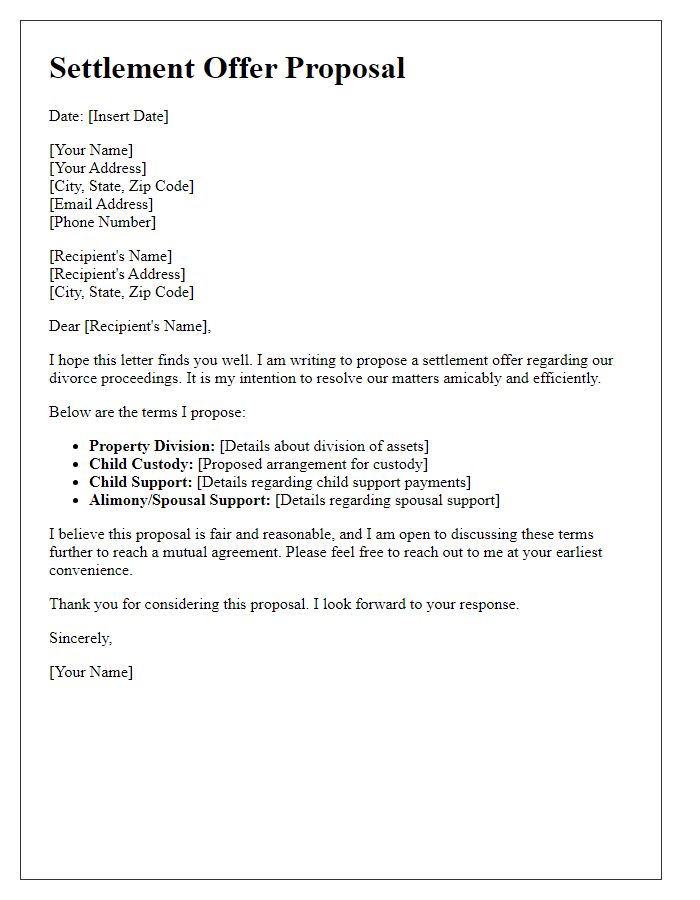Are you ready to negotiate a fair settlement and put your dispute behind you? Writing a letter for a settlement offer proposal doesn't have to be daunting; in fact, it can be quite straightforward! By clearly outlining your terms and expressing a willingness to find common ground, you can pave the way for a successful resolution. Join us as we explore effective strategies and tips for crafting an impactful settlement offer letter!

Clear identification of parties involved
In a settlement offer proposal, clear identification of parties involved ensures proper recognition of all entities participating in the agreement. For instance, the primary party could be "John Smith," a plaintiff residing at 123 Main Street, Springfield, ZIP Code 12345, while the opposing party may be "ABC Corporation," located at 456 Corporate Avenue, Springfield, ZIP Code 12345. Accurate identification routinely includes the legal representatives, such as "Smith & Associates Law Firm" for John Smith and "XYZ Legal Services" for ABC Corporation. Additionally, inclusion of case numbers (such as Case No. 2023-CV-456) and relevant court details (e.g., Springfield County Superior Court) establishes context and legitimizes the proposal. This level of detail guarantees clarity regarding who is involved, enabling effective communication and fostering the potential for resolution.
Detailed description of the dispute or issue
The recent dispute pertains to a breach of contract concerning the supply of construction materials, specifically the agreement dated March 1, 2023, between ABC Construction Ltd. and XYZ Supply Co. The contract outlined a provision for the delivery of 500 tons of concrete by June 15, 2023, at a total cost of $50,000. However, delivery was delayed until July 30, 2023, due to logistical issues on the part of XYZ Supply Co., resulting in financial losses estimated at $15,000 for ABC Construction Ltd. Additionally, this delay severely impacted the project timeline at 123 Main St., a key construction site in Downtown Springfield, which was scheduled for completion by August 2023. The failure to adhere to the delivery timeline not only caused disruptions but also damaged the professional relationship between both parties, leading to a need for resolution through a settlement offer proposal.
Specific settlement terms and conditions
A settlement offer proposal typically outlines the terms and conditions for resolving a dispute outside of court. Key elements include the primary offer amount, which may vary based on case specifics, conditional agreements such as non-disclosure or confidentiality clauses, payment timelines like within 30 days after acceptance, and a clause for mutual release indicating both parties will drop further claims. Additionally, considerations may include the stipulation of jurisdiction, often stating the applicable law from a specific state, and any associated attorney fees that may be compensated as part of the settlement agreement. This framework ensures clarity and minimizes future legal disputes.
Justification and rationale for the proposal
The settlement offer proposal presents a fair compromise aimed at resolving outstanding disputes related to financial obligations, specifically an agreed amount of $50,000. This figure represents a significant reduction from the original claim of $75,000, reflecting a commitment to mutual resolution while acknowledging the financial challenges faced by both parties. Key considerations include the potential costs associated with prolonged litigation, estimated at $10,000 in legal fees and expenses, alongside the emotional toll and uncertainty that can arise from extended court proceedings in District Court. The proposal offers an efficient resolution process, targeting a settlement by November 30, 2023, to facilitate a swift return to normal business operations for both parties involved, thereby allowing for a focus on future growth and collaboration rather than prolonged conflict.
Deadline for response and contact information
A settlement offer proposal outlines the terms aimed at resolving a dispute without resorting to litigation. Typically, proposals include a deadline for response, which usually spans 14 to 30 days, ensuring timeliness and encouraging prompt negotiations. Contact information should include the name of the sender, title, organization, phone number, and email address for further communication. A clear and concise proposal facilitates effective dialogue between opposing parties, fostering an environment conducive to resolution while maintaining professionalism and clarity.
Letter Template For Settlement Offer Proposal Samples
Letter template of a formal settlement offer proposal for legal disputes

Letter template of an amicable settlement offer proposal in business negotiations

Letter template of a settlement offer proposal for employment-related claims











Comments